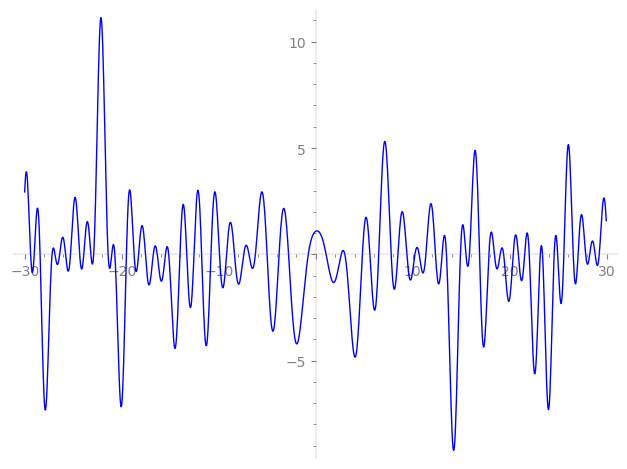| L(s) = 1 | + (−0.704 + 1.22i)2-s + (−0.0771 − 0.133i)3-s + (0.00725 + 0.0125i)4-s + 0.217·6-s + (−1.20 − 2.08i)7-s − 2.83·8-s + (1.48 − 2.57i)9-s − 4.38·11-s + (0.00112 − 0.00194i)12-s + (1.99 + 3.45i)13-s + 3.39·14-s + (1.98 − 3.43i)16-s + (0.776 − 1.34i)17-s + (2.09 + 3.63i)18-s + (0.736 + 1.27i)19-s + ⋯ |
| L(s) = 1 | + (−0.498 + 0.862i)2-s + (−0.0445 − 0.0771i)3-s + (0.00362 + 0.00628i)4-s + 0.0887·6-s + (−0.455 − 0.789i)7-s − 1.00·8-s + (0.496 − 0.859i)9-s − 1.32·11-s + (0.000323 − 0.000560i)12-s + (0.553 + 0.958i)13-s + 0.908·14-s + (0.496 − 0.859i)16-s + (0.188 − 0.326i)17-s + (0.494 + 0.856i)18-s + (0.168 + 0.292i)19-s + ⋯ |
\[\begin{aligned}\Lambda(s)=\mathstrut & 925 ^{s/2} \, \Gamma_{\C}(s) \, L(s)\cr =\mathstrut & (0.890 - 0.455i)\, \overline{\Lambda}(2-s) \end{aligned}\]
\[\begin{aligned}\Lambda(s)=\mathstrut & 925 ^{s/2} \, \Gamma_{\C}(s+1/2) \, L(s)\cr =\mathstrut & (0.890 - 0.455i)\, \overline{\Lambda}(1-s) \end{aligned}\]
Particular Values
| \(L(1)\) |
\(\approx\) |
\(1.05648 + 0.254437i\) |
| \(L(\frac12)\) |
\(\approx\) |
\(1.05648 + 0.254437i\) |
| \(L(\frac{3}{2})\) |
|
not available |
| \(L(1)\) |
|
not available |
\(L(s) = \displaystyle \prod_{p} F_p(p^{-s})^{-1} \)
| $p$ | $F_p(T)$ |
|---|
| bad | 5 | \( 1 \) |
| 37 | \( 1 + (-5.76 + 1.94i)T \) |
| good | 2 | \( 1 + (0.704 - 1.22i)T + (-1 - 1.73i)T^{2} \) |
| 3 | \( 1 + (0.0771 + 0.133i)T + (-1.5 + 2.59i)T^{2} \) |
| 7 | \( 1 + (1.20 + 2.08i)T + (-3.5 + 6.06i)T^{2} \) |
| 11 | \( 1 + 4.38T + 11T^{2} \) |
| 13 | \( 1 + (-1.99 - 3.45i)T + (-6.5 + 11.2i)T^{2} \) |
| 17 | \( 1 + (-0.776 + 1.34i)T + (-8.5 - 14.7i)T^{2} \) |
| 19 | \( 1 + (-0.736 - 1.27i)T + (-9.5 + 16.4i)T^{2} \) |
| 23 | \( 1 - 9.41T + 23T^{2} \) |
| 29 | \( 1 - 3.09T + 29T^{2} \) |
| 31 | \( 1 - 8.30T + 31T^{2} \) |
| 41 | \( 1 + (4.05 + 7.01i)T + (-20.5 + 35.5i)T^{2} \) |
| 43 | \( 1 - 2.66T + 43T^{2} \) |
| 47 | \( 1 + 1.40T + 47T^{2} \) |
| 53 | \( 1 + (-4.36 + 7.55i)T + (-26.5 - 45.8i)T^{2} \) |
| 59 | \( 1 + (3.94 - 6.82i)T + (-29.5 - 51.0i)T^{2} \) |
| 61 | \( 1 + (0.760 + 1.31i)T + (-30.5 + 52.8i)T^{2} \) |
| 67 | \( 1 + (2.41 + 4.18i)T + (-33.5 + 58.0i)T^{2} \) |
| 71 | \( 1 + (4.93 + 8.54i)T + (-35.5 + 61.4i)T^{2} \) |
| 73 | \( 1 - 11.0T + 73T^{2} \) |
| 79 | \( 1 + (-8.24 - 14.2i)T + (-39.5 + 68.4i)T^{2} \) |
| 83 | \( 1 + (3.26 - 5.65i)T + (-41.5 - 71.8i)T^{2} \) |
| 89 | \( 1 + (-6.38 + 11.0i)T + (-44.5 - 77.0i)T^{2} \) |
| 97 | \( 1 + 14.4T + 97T^{2} \) |
| show more | |
| show less | |
\(L(s) = \displaystyle\prod_p \ \prod_{j=1}^{2} (1 - \alpha_{j,p}\, p^{-s})^{-1}\)
Imaginary part of the first few zeros on the critical line
−9.920824509631618796326536372824, −9.189762358141939507933713720113, −8.373094562846591409982216277130, −7.42657457573440554441277555976, −6.88039960918934253768674949608, −6.21968170054397368639756599223, −5.01451199152353503125489890344, −3.77738848691483966562543248662, −2.79955390051627797099936921782, −0.76559932295392952075518213038,
1.06864257162427143586615858877, 2.62565249947027894721696545984, 2.99938442023484634681650020275, 4.80994068622798604514909336464, 5.58212899219694219887350276400, 6.49432106205305731399523624197, 7.77642141105617477160480097775, 8.474284665808948273298751548137, 9.392569425114095968878248013511, 10.22727708971603331367603687884

